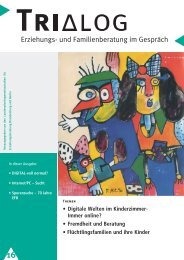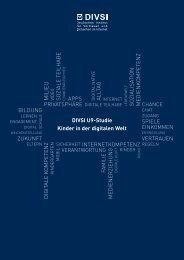ora-schriften-s-2013
ora-schriften-s-2013
ora-schriften-s-2013
Create successful ePaper yourself
Turn your PDF publications into a flip-book with our unique Google optimized e-Paper software.
Cybergrooming in the context of criminal prosecution<br />
different in the case of cybergrooming. In<br />
many cases the anonymity of the Internet<br />
enables the offender to mask his true<br />
intentions and encounter an innocent<br />
counterpart who does not recognise the<br />
risks or the consequences of his/her acts. 15<br />
This real risk to children can only be tackled<br />
by means of protection under the criminal<br />
law that kicks in at a sufficiently early stage<br />
and suitable preventative measures.<br />
b) Inducing<br />
According to section 176 (4) (3) StGB the<br />
prerequisite for the commission of the<br />
offence is “inducing” children through the<br />
presentation of “written materials”. The very<br />
determination of when an offender has<br />
induced a child in the manner defined by<br />
this Act presents certain difficulties in the<br />
absence of case-law from the highest<br />
judicial instance in relation to section 176<br />
(4) (3) StGB. Considering the case law of<br />
the German Federal Supreme Court<br />
(Bundesgerichtshof) – in fact in respect of a<br />
different offence, namely the old offence of<br />
human trafficking under section 180 b I<br />
sentence 2 StGB (now section 232 StGB)<br />
– which contained the element of “inducing”,<br />
this is understood to be the exertion of a<br />
direct psychological influence that is<br />
characterised by a degree of tenacity, such<br />
as repeated urging, persuasion, promising,<br />
arousing curiosity, use of authority,<br />
deception, intimidation and threats. 16 This<br />
apt definition, which contains a restricting<br />
and clearly delimited depiction of punishable<br />
conduct to satisfy the principle of legal<br />
certainty, can also be used as a definition<br />
pursuant to section 176 (4) (3) StGB<br />
according to prevailing opinion. 17<br />
However, this also shows that a one-off<br />
inducement of children, which is not<br />
continued for whatever reasons, does not<br />
represent punishable inducement as<br />
15 Cf. also the article by Rüdiger by way of summary<br />
16 cf. BGHSt 45, 158; BGH NStZ 2000, 86<br />
17 cf. NStZ 2011, 455; BGHSt 29, 30; NStZ 1991,<br />
45<br />
defined by this Act. Because the attempt<br />
is not a punishable offence, one-off<br />
inducement cannot be punished.<br />
c) Concept of written materials<br />
The inducement of a child must be by way<br />
of “written materials”. Influencing a child by<br />
means of a direct personal communication<br />
or a telephone call is not covered by the<br />
section. As for the concept of written<br />
materials section 176 (4) (3) StGB in turn<br />
refers to section 11 StGB, which for its part<br />
contains what is called an equalisation<br />
clause in section 11 (3) StGB.<br />
Section 11 (III) StGB reads:<br />
“[...] Audiovisual media, data st<strong>ora</strong>ge<br />
media, illustrations and other depictions<br />
shall be equivalent to written material in the<br />
provisions which refer to this subsection.”<br />
It is generally acknowledged that chat<br />
protocols or communications during an<br />
online game do not represent written<br />
material as defined by section 11 StGB.<br />
The question raised in the public debate as<br />
to why something written does not amount<br />
to written material can only be explained by<br />
the strict criteria under section 11 StGB.<br />
This requires the concept of “written<br />
material” to be an embodiment and<br />
therefore only describes the written word<br />
on paper or other transportable material<br />
that can be readily perceived by anyone. 18<br />
It therefore follows that in the case of<br />
“cybergrooming” solely the concept of “data<br />
st<strong>ora</strong>ge media” can be relevant for<br />
establishing the offence. The concept of<br />
“data st<strong>ora</strong>ge media”, which was not<br />
inserted into section 11 (3) StGB until<br />
1997, 19 is initially understood to mean<br />
st<strong>ora</strong>ge media for electronic, electromagnetic,<br />
optical, chemical or other<br />
18 cf. Prof. Dr. Marco Gercke, Aufsatz “Was wirklich<br />
strafbar ist-vielleicht” dated 20 October 2010<br />
from “Legal Tribune-Online”<br />
19 inserted by Art. 4) (1) German Information and<br />
Communication Services Act (Informations- und<br />
Kommunikationsdienste-Gesetz, IuKDG) dated<br />
22 July 1997 [BGBL. I 1870]; RegE BT-Drs.<br />
13/7385, 35<br />
In many cases<br />
the anonymity of<br />
the Internet<br />
enables the<br />
offender to mask<br />
his true intentions<br />
and encounter<br />
an innocent<br />
counterpart who<br />
does not recognise<br />
the risks or<br />
the consequences<br />
of his/<br />
her acts.<br />
Special Edition <strong>2013</strong><br />
29





